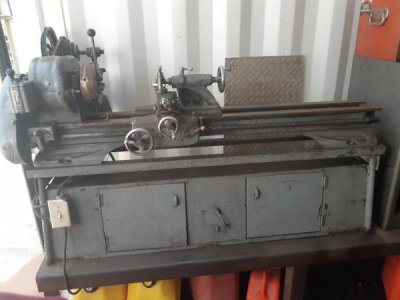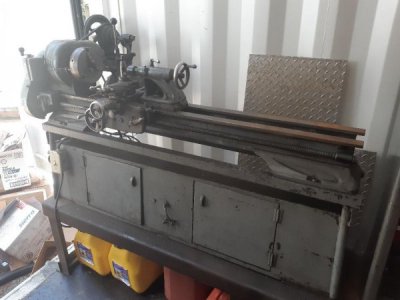-
Welcome back Guest! Did you know you can mentor other members here at H-M? If not, please check out our Relaunch of Hobby Machinist Mentoring Program!
You are using an out of date browser. It may not display this or other websites correctly.
You should upgrade or use an alternative browser.
You should upgrade or use an alternative browser.
Rough estimate on Atlas 10f?
- Thread starter Firewood
- Start date
- Joined
- Oct 10, 2018
- Messages
- 545
Um, I see bolt heads in the normal spots for attaching the lathe feet to the stand. I can't make out any evidence of welding?!?These are the images of the lathe in question. I believe he said the bed is 44" and the motor is 220V.
View attachment 300894View attachment 300895
The top of the base is interesting; it appears to be highly polished since we can see the reflection of the diamond plate behind. Certainly a sturdy-looking stand.
BTW, it looks like a TH54 model. "T" means Timken bearings. "H" as it has the horizontal countershaft system rather than vertical. "54" as that is (I think) the bed length including the headstock.
Bit of rust on the tailstock end of the ways but that should clean off easily with a razor scraper. No way to make out how much wear there is in the bed, however.
Have you examined the machine in person?
Craig
- Joined
- Dec 25, 2011
- Messages
- 10,552
I started to make the same comment about the bolt heads and lack of any visible evidence of welding or brazing yesterday. Assuming that it was listed for sale online somewhere, did the write-up say that the legs were welded to the bench? Another point is that the legs are cast iron while the bench is probably steel. So they would probably have been brazed instead of welded. Although why anyone would go to the trouble to do that is a mystery to me.
Yes, 54" is the nominal length of the longest bed that Atlas made. This is the length of the ways, which are just slightly longer than the rest of the bed below them. The 54" includes about 12" that the headstock sits on and about 6" that the tailstock sits on, leaving approximately 36" between the tip of a dead center in the spindle and the tip of a dead center in the tailstock ram with the ram retracted to the zero mark and with the tailstock sitting on the bed with its right end flush with the right ends of the ways.
Yes, 54" is the nominal length of the longest bed that Atlas made. This is the length of the ways, which are just slightly longer than the rest of the bed below them. The 54" includes about 12" that the headstock sits on and about 6" that the tailstock sits on, leaving approximately 36" between the tip of a dead center in the spindle and the tip of a dead center in the tailstock ram with the ram retracted to the zero mark and with the tailstock sitting on the bed with its right end flush with the right ends of the ways.
I haven't view it in person (yet?). Its a bit of a drive, but not too crazy. I'm pretty sure that's not a reflection but a hole in the stand with no back to it. The owner told me the lathe is welded to the stand, and in my mind that means the lathe itself, because otherwise he would have said the stand is welded to a bench. But it could definitely have been a miscommunication.
Do you guys seem more positive about it now?
Do you guys seem more positive about it now?
- Joined
- Dec 25, 2011
- Messages
- 10,552
Yep, you're right. The top of the stand isn't solid. When I adjusted my eyes, I realized that through the opening, you can see the corrugated siding and the piece of diamond deck plate leaning against the siding.
I still can't say whether or not the legs are in fact welded or brazed to the stand. If the owner says that they are, then I guess that they are. But we don't know whether the owner correctly understands what part of what's visible came from Atlas and what part didn't. I'm afraid that the only way you are going to find out what the true situation is, is to go and look at it. Given the situation (where you and the lathe are and the general availability of machine tools in your area) I think that I would make the drive. But I would also be prepared to tell the current owner that I only wanted the lathe itself, and not the stand.
I still can't say whether or not the legs are in fact welded or brazed to the stand. If the owner says that they are, then I guess that they are. But we don't know whether the owner correctly understands what part of what's visible came from Atlas and what part didn't. I'm afraid that the only way you are going to find out what the true situation is, is to go and look at it. Given the situation (where you and the lathe are and the general availability of machine tools in your area) I think that I would make the drive. But I would also be prepared to tell the current owner that I only wanted the lathe itself, and not the stand.
- Joined
- Oct 10, 2018
- Messages
- 545
Looks like crossed wires to me. It is a bit of an odd stand--apparently no place to store tools or even just a place to put them down.... The owner told me the lathe is welded to the stand [...] But it could definitely have been a miscommunication.
Do you guys seem more positive about it now?
If the machine is still available, perhaps you can get the seller to clarify about how it is attached. The issue is "levelling" the lathe. To get the axis of rotation really parallel with the bed of the lathe, it is common to put shims under one or more of the lathe's feet. If the machine is bolted down, that's trivial to do; if brazed or welded, it's impossible. Plus, it is a lot easier to move a machine if you can separate it from the stand.
Craig
- Joined
- Dec 25, 2011
- Messages
- 10,552
I think that's a good synopsis. If the legs are welded to the stand, pass. If he was referring to something else, go and look at it. But if what we think that we now know about the stand is correct (no back or top), I wouldn't take the stand.
- Joined
- Dec 9, 2016
- Messages
- 1,133
Could be the legs are welded to the "Stand" not the Lathe. Maybe he was asked if the bench itself comes apart for transport but the lathe is bolted to the bench. Also that bench top look to only have a front rail running the lathes length left to right but front to back looks to be "floating" in a sense but im sure it has some kind of support under the lathes back bed legs.
- Joined
- Dec 12, 2011
- Messages
- 132
If you blow the pictures up and play with brightness/contrast you can see that the top of the bench is a rectangle made from angle and the part with the doors is a box that was probably something else at one time. No signs of welding but could be on the inside of the legs at the edge of the angle iron .It sure would be interesting to look at it in person.
HWF
HWF
Last edited:


